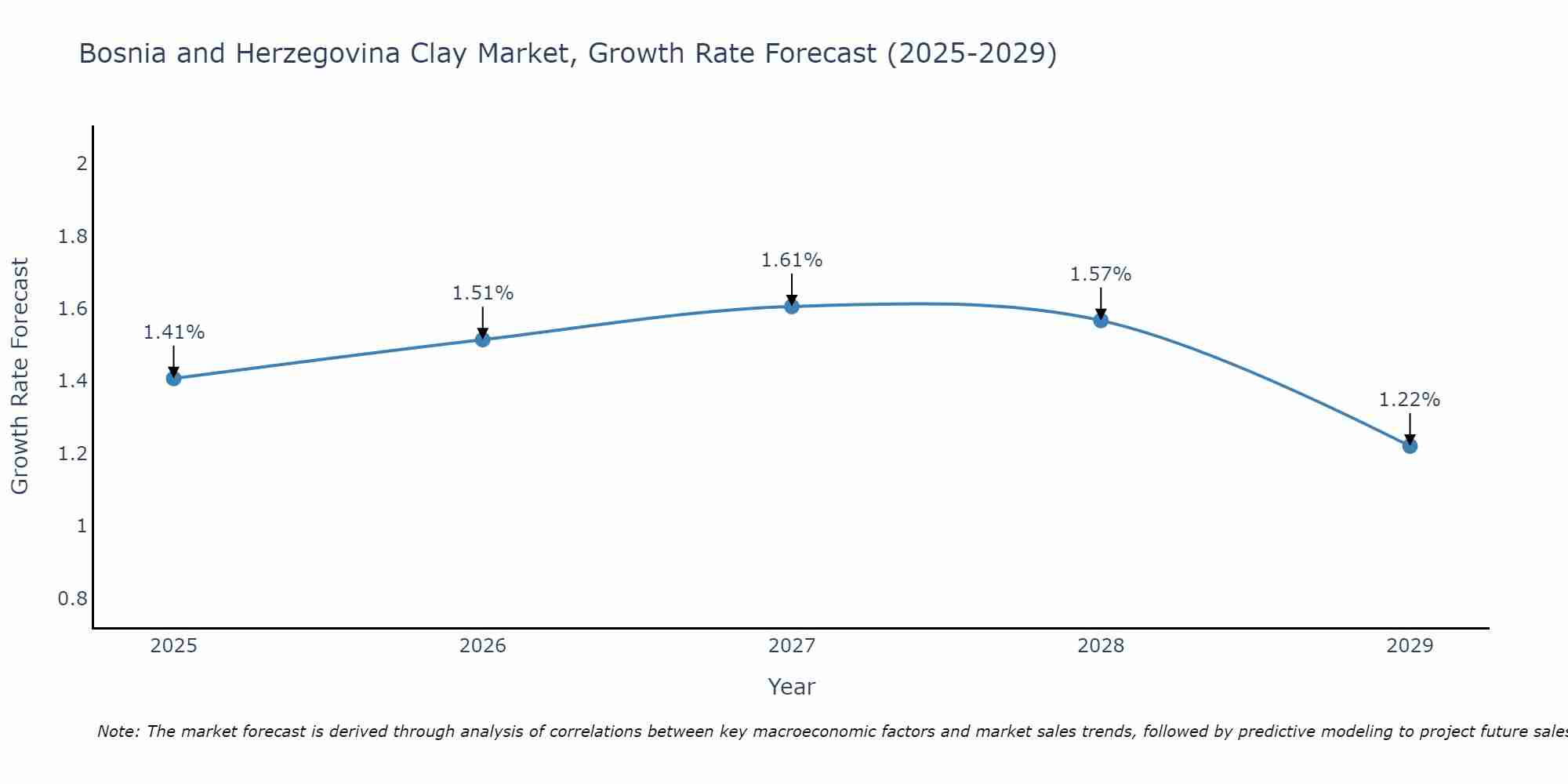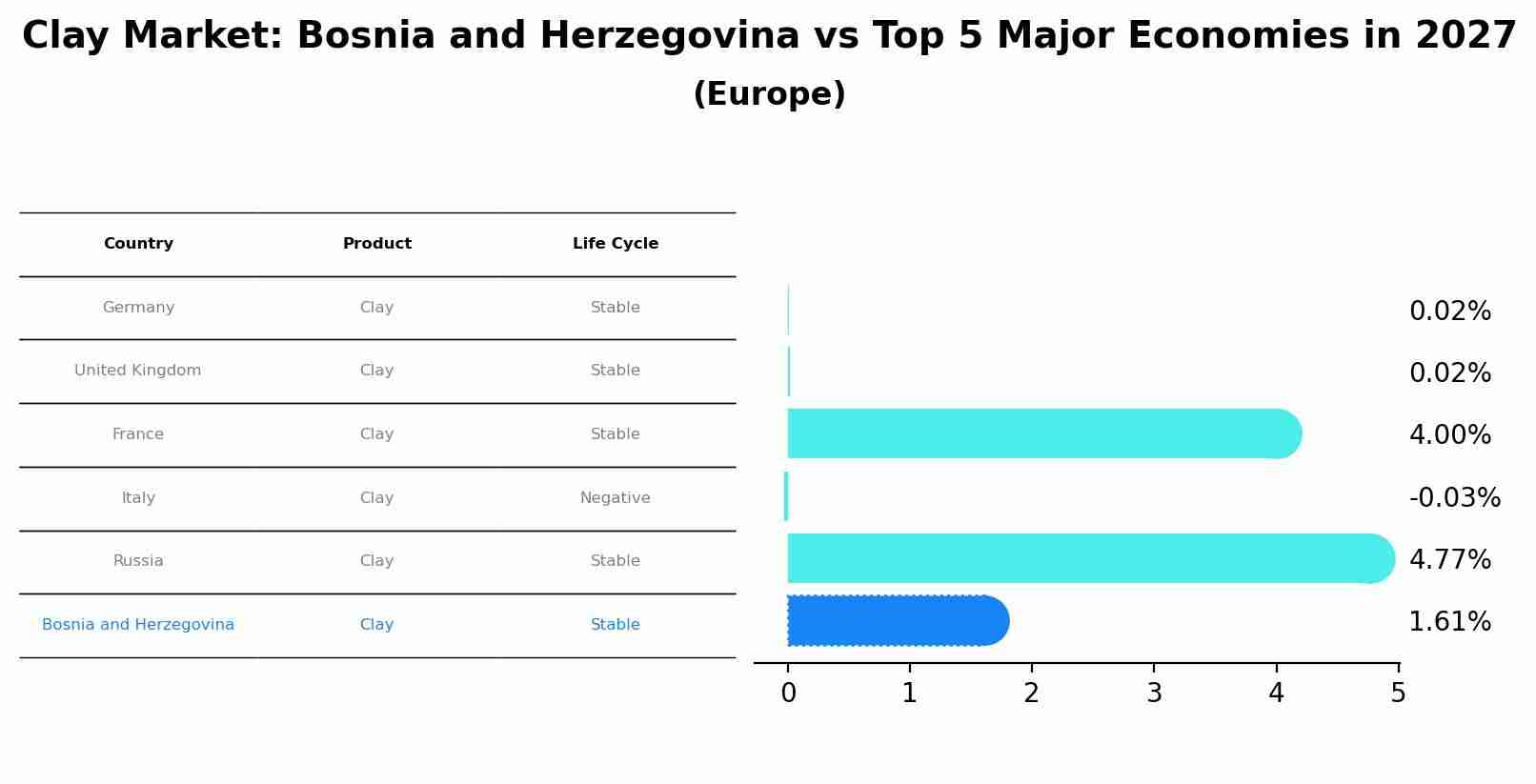Bosnia and Herzegovina Clay Market (2025-2031) | Share, Segmentation, Value, Outlook, Forecast, Growth, Revenue, Companies, Industry, Analysis, Size & Trends
| Product Code: ETC5257631 | Publication Date: Nov 2023 | Updated Date: Oct 2025 | Product Type: Market Research Report | |
| Publisher: 6Wresearch | Author: Bhawna Singh | No. of Pages: 60 | No. of Figures: 30 | No. of Tables: 5 |
Bosnia and Herzegovina Clay Market Size Growth Rate
The Bosnia and Herzegovina Clay Market is projected to witness mixed growth rate patterns during 2025 to 2029. Starting at 1.41% in 2025, the market peaks at 1.61% in 2027, and settles at 1.22% by 2029.

Clay Market: Bosnia and Herzegovina vs Top 5 Major Economies in 2027 (Europe)
By 2027, the Clay market in Bosnia and Herzegovina is anticipated to reach a growth rate of 1.61%, as part of an increasingly competitive Europe region, where Germany remains at the forefront, supported by United Kingdom, France, Italy and Russia, driving innovations and market adoption across sectors.

Bosnia and Herzegovina Clay Market Overview
The clay market in Bosnia and Herzegovina is driven by its use in construction, ceramics, and pottery. Clay is a vital raw material for the building industry, used in the production of bricks, tiles, and other construction materials. The market is influenced by the construction industry`s demand and the availability of clay deposits in the region. The ceramics and pottery sectors also contribute to the market`s growth.
Drivers of the market
The clay market in Bosnia and Herzegovina is driven by its widespread use in construction, ceramics, and refractories. The ongoing infrastructure development and construction activities in the country contribute significantly to the demand for clay products. Additionally, the growing ceramics industry, driven by both domestic and export markets, along with the demand for refractory materials in various industrial processes, supports market growth.
Challenges of the market
The clay market in Bosnia and Herzegovina faces challenges related to the limited scale of mining operations and production capabilities. The market is further constrained by the competition from imported clay products, which can offer better quality or lower prices. Additionally, fluctuations in construction activities, which are a major consumer of clay products, directly impact market demand.
Government Policy of the market
Government policies in the clay market of Bosnia and Herzegovina are centered around the regulation of mining activities, environmental protection, and the promotion of sustainable resource extraction. The government issues permits for clay extraction and enforces environmental regulations to minimize the impact on the environment. There are also policies aimed at supporting local industries that use clay as a raw material, such as ceramics and construction.
Key Highlights of the Report:
- Bosnia and Herzegovina Clay Market Outlook
- Market Size of Bosnia and Herzegovina Clay Market, 2024
- Forecast of Bosnia and Herzegovina Clay Market, 2031
- Historical Data and Forecast of Bosnia and Herzegovina Clay Revenues & Volume for the Period 2021-2031
- Bosnia and Herzegovina Clay Market Trend Evolution
- Bosnia and Herzegovina Clay Market Drivers and Challenges
- Bosnia and Herzegovina Clay Price Trends
- Bosnia and Herzegovina Clay Porter`s Five Forces
- Bosnia and Herzegovina Clay Industry Life Cycle
- Historical Data and Forecast of Bosnia and Herzegovina Clay Market Revenues & Volume By Application for the Period 2021-2031
- Historical Data and Forecast of Bosnia and Herzegovina Clay Market Revenues & Volume By Tableware for the Period 2021-2031
- Historical Data and Forecast of Bosnia and Herzegovina Clay Market Revenues & Volume By Sanitary ware for the Period 2021-2031
- Historical Data and Forecast of Bosnia and Herzegovina Clay Market Revenues & Volume By Medical applications for the Period 2021-2031
- Historical Data and Forecast of Bosnia and Herzegovina Clay Market Revenues & Volume By End Use for the Period 2021-2031
- Historical Data and Forecast of Bosnia and Herzegovina Clay Market Revenues & Volume By Ceramic and for the Period 2021-2031
- Historical Data and Forecast of Bosnia and Herzegovina Clay Market Revenues & Volume By Non-ceramic for the Period 2021-2031
- Bosnia and Herzegovina Clay Import Export Trade Statistics
- Market Opportunity Assessment By Application
- Market Opportunity Assessment By End Use
- Bosnia and Herzegovina Clay Top Companies Market Share
- Bosnia and Herzegovina Clay Competitive Benchmarking By Technical and Operational Parameters
- Bosnia and Herzegovina Clay Company Profiles
- Bosnia and Herzegovina Clay Key Strategic Recommendations
Frequently Asked Questions About the Market Study (FAQs):
1 Executive Summary |
2 Introduction |
2.1 Key Highlights of the Report |
2.2 Report Description |
2.3 Market Scope & Segmentation |
2.4 Research Methodology |
2.5 Assumptions |
3 Bosnia and Herzegovina Clay Market Overview |
3.1 Bosnia and Herzegovina Country Macro Economic Indicators |
3.2 Bosnia and Herzegovina Clay Market Revenues & Volume, 2021 & 2031F |
3.3 Bosnia and Herzegovina Clay Market - Industry Life Cycle |
3.4 Bosnia and Herzegovina Clay Market - Porter's Five Forces |
3.5 Bosnia and Herzegovina Clay Market Revenues & Volume Share, By Application, 2021 & 2031F |
3.6 Bosnia and Herzegovina Clay Market Revenues & Volume Share, By End Use, 2021 & 2031F |
4 Bosnia and Herzegovina Clay Market Dynamics |
4.1 Impact Analysis |
4.2 Market Drivers |
4.2.1 Increasing construction activities in Bosnia and Herzegovina |
4.2.2 Growing demand for clay in ceramics and pottery industries |
4.2.3 Favorable government policies supporting the mining sector |
4.3 Market Restraints |
4.3.1 Fluctuating raw material prices impacting clay production costs |
4.3.2 Environmental regulations affecting mining and extraction processes |
5 Bosnia and Herzegovina Clay Market Trends |
6 Bosnia and Herzegovina Clay Market Segmentations |
6.1 Bosnia and Herzegovina Clay Market, By Application |
6.1.1 Overview and Analysis |
6.1.2 Bosnia and Herzegovina Clay Market Revenues & Volume, By Tableware, 2021-2031F |
6.1.3 Bosnia and Herzegovina Clay Market Revenues & Volume, By Sanitary ware, 2021-2031F |
6.1.4 Bosnia and Herzegovina Clay Market Revenues & Volume, By Medical applications, 2021-2031F |
6.2 Bosnia and Herzegovina Clay Market, By End Use |
6.2.1 Overview and Analysis |
6.2.2 Bosnia and Herzegovina Clay Market Revenues & Volume, By Ceramic and, 2021-2031F |
6.2.3 Bosnia and Herzegovina Clay Market Revenues & Volume, By Non-ceramic, 2021-2031F |
7 Bosnia and Herzegovina Clay Market Import-Export Trade Statistics |
7.1 Bosnia and Herzegovina Clay Market Export to Major Countries |
7.2 Bosnia and Herzegovina Clay Market Imports from Major Countries |
8 Bosnia and Herzegovina Clay Market Key Performance Indicators |
8.1 Average selling price of clay products |
8.2 Number of new construction projects utilizing clay products |
8.3 Investment trends in the ceramics and pottery industries |
9 Bosnia and Herzegovina Clay Market - Opportunity Assessment |
9.1 Bosnia and Herzegovina Clay Market Opportunity Assessment, By Application, 2021 & 2031F |
9.2 Bosnia and Herzegovina Clay Market Opportunity Assessment, By End Use, 2021 & 2031F |
10 Bosnia and Herzegovina Clay Market - Competitive Landscape |
10.1 Bosnia and Herzegovina Clay Market Revenue Share, By Companies, 2024 |
10.2 Bosnia and Herzegovina Clay Market Competitive Benchmarking, By Operating and Technical Parameters |
11 Company Profiles |
12 Recommendations | 13 Disclaimer |
- Single User License$ 1,995
- Department License$ 2,400
- Site License$ 3,120
- Global License$ 3,795
Search
Related Reports
- ASEAN and Thailand Brain Health Supplements Market (2025-2031) | Strategy, Consumer Insights, Analysis, Investment Trends, Opportunities, Growth, Size, Share, Industry, Revenue, Segments, Value, Segmentation, Supply, Forecast, Restraints, Outlook, Competition, Drivers, Trends, Demand, Pricing Analysis, Competitive, Strategic Insights, Companies, Challenges
- ASEAN Bearings Market (2025-2031) | Strategy, Consumer Insights, Analysis, Investment Trends, Opportunities, Growth, Size, Share, Industry, Revenue, Segments, Value, Segmentation, Supply, Forecast, Restraints, Outlook, Competition, Drivers, Trends, Demand, Pricing Analysis, Competitive, Strategic Insights, Companies, Challenges
- Europe Flooring Market (2025-2031) | Outlook, Share, Industry, Trends, Forecast, Companies, Revenue, Size, Analysis, Growth & Value
- Saudi Arabia Manlift Market (2025-2031) | Outlook, Size, Growth, Trends, Companies, Industry, Revenue, Value, Share, Forecast & Analysis
- Uganda Excavator, Crane, and Wheel Loaders Market (2025-2031) | Strategy, Consumer Insights, Analysis, Investment Trends, Opportunities, Growth, Size, Share, Industry, Revenue, Segments, Value, Segmentation, Supply, Forecast, Restraints, Outlook, Competition, Drivers, Trends, Demand, Pricing Analysis, Competitive, Strategic Insights, Companies, Challenges
- Rwanda Excavator, Crane, and Wheel Loaders Market (2025-2031) | Strategy, Consumer Insights, Analysis, Investment Trends, Opportunities, Growth, Size, Share, Industry, Revenue, Segments, Value, Segmentation, Supply, Forecast, Restraints, Outlook, Competition, Drivers, Trends, Demand, Pricing Analysis, Competitive, Strategic Insights, Companies, Challenges
- Kenya Excavator, Crane, and Wheel Loaders Market (2025-2031) | Strategy, Consumer Insights, Analysis, Investment Trends, Opportunities, Growth, Size, Share, Industry, Revenue, Segments, Value, Segmentation, Supply, Forecast, Restraints, Outlook, Competition, Drivers, Trends, Demand, Pricing Analysis, Competitive, Strategic Insights, Companies, Challenges
- Angola Excavator, Crane, and Wheel Loaders Market (2025-2031) | Strategy, Consumer Insights, Analysis, Investment Trends, Opportunities, Growth, Size, Share, Industry, Revenue, Segments, Value, Segmentation, Supply, Forecast, Restraints, Outlook, Competition, Drivers, Trends, Demand, Pricing Analysis, Competitive, Strategic Insights, Companies, Challenges
- Israel Intelligent Transport System Market (2025-2031) | Strategy, Consumer Insights, Analysis, Investment Trends, Opportunities, Growth, Size, Share, Industry, Revenue, Segments, Value, Segmentation, Supply, Forecast, Restraints, Outlook, Competition, Drivers, Trends, Demand, Pricing Analysis, Competitive, Strategic Insights, Companies, Challenges
- Uganda Precast and Aggregate Market (2025-2031) | Strategy, Consumer Insights, Analysis, Investment Trends, Opportunities, Growth, Size, Share, Industry, Revenue, Segments, Value, Segmentation, Supply, Forecast, Restraints, Outlook, Competition, Drivers, Trends, Demand, Pricing Analysis, Competitive, Strategic Insights, Companies, Challenges
Industry Events and Analyst Meet
Our Clients
Whitepaper
- Middle East & Africa Commercial Security Market Click here to view more.
- Middle East & Africa Fire Safety Systems & Equipment Market Click here to view more.
- GCC Drone Market Click here to view more.
- Middle East Lighting Fixture Market Click here to view more.
- GCC Physical & Perimeter Security Market Click here to view more.
6WResearch In News
- Doha a strategic location for EV manufacturing hub: IPA Qatar
- Demand for luxury TVs surging in the GCC, says Samsung
- Empowering Growth: The Thriving Journey of Bangladesh’s Cable Industry
- Demand for luxury TVs surging in the GCC, says Samsung
- Video call with a traditional healer? Once unthinkable, it’s now common in South Africa
- Intelligent Buildings To Smooth GCC’s Path To Net Zero













